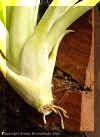
 click photo for a larger image.
1 2
click photo for a larger image.
1 2Tillandsias grow differently to most other cultivated plants, so can be confusing to the beginner. They are really very hardy, and require much less attention than other ornamentals:
for a more detailed discussion of growing conditions, click here.

click photo for a larger image. 1 2
Tillandsias can be glued or tied to most things, except bare metal. Don’t fix them to metal, and don’t tie them with uncovered wire. Use a glue that is waterproof (pva glues tend to be too weak) and does not have volatile solvents such as Araldite. We have found wallboard glues to be the best, we use "Liquid Nails" (In the US, "Plumbers Goop" is similar). For convenience, we also use a hot glue gun for commercial work—leaving the glue for about 5 seconds before applying the plant.
The plant needs to be attached firmly, and if you are using glue try not to have the glue covering the whole base of the plant.We try to glue the plants sideways and at a slight angle (photo 1) so that one side of the base and a short distance up the back of the plant are fixed, allowing new roots to form at the non-glued base section. If you have a plant with a round flat base (T. ionantha, T. magnusiana for example) you may have to fix it straight out from the mount (photo 2)—in this case we make an incomplete circle with the glue so roots can form in the centre or side of the base and have a way out from under.